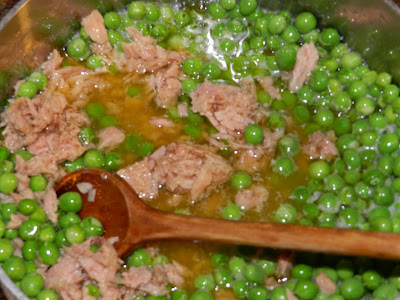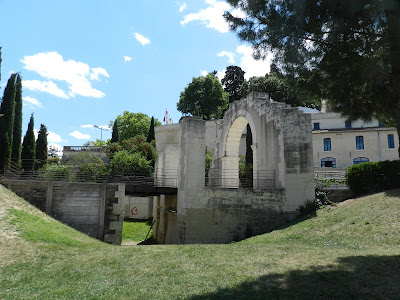Good lord, it's not like there's nothing going on around here, but this book project is just taking up all my time and at the end of three hours of putting this proposal together, with all the minute detail-work that entails, and watching it grow to 40,000 words (2/3 of the size of a normal book) and knowing it's just an outline, for heaven's sakes, I really don't feel witty enough to sit down and write an entertaining blog-post about life in Montpellier. Not that I've experienced much of it, since I spend the days sitting here at the desk alternately staring at columns of data and the screen and the courtyard outside, where new tenants appear to be doing heavy renovation. Fortunately, 15 years in Berlin inured me to the sound of construction, but banging and shouting doesn't really make writing any easier.
Fortunately, though, the markets are filling up with great stuff -- I just had some yellow peaches that were so good I can't remember the last time I had any that were so tasty -- and among the things that are coming in are our old friends the solenaceae, that family of New World plants that have made themselves a nice home in southern Europe, and includes tomatoes, peppers, and eggplant. That last one is something people look at and often wonder what to do with, and I'm no exception. I've already covered ratatouille, that local favorite, when I got a bunch of beautiful ivory-colored eggplants and made White Rat. But there's another recipe I've been playing around with, and it came from a guy who uses the handle almanac on the Well, the amazing online community that may or may not just have gotten killed yesterday by its owner, Salon. (I'll have more on that, probably, on my other blog on Wednesday).
Anyway, this guy posted a recipe a year or so ago and I've been messing with it ever since, and, as you'll see, have aspects as yet un-messed-with. But last week I was at the market, saw some actual real live non-greenhouse-looking eggplants, the season's first, and said aha! Time to make Penne al'Almanache! Yes, it's sort of a distant relative of pasta alla Norma, but it's got a couple of things that make it different. Anyway, here'w what you need to make it:
Actually, not all of this counts, but you've got, sort of going clockwise, the eggplants, not the parsley, but the plant next to it which is the Provençal small-leaf basil (although you can use the more common kind -- I just had this lying around), Balsamic vinegar, canned tomatoes, garlic, onion, oregano, and salt.
Now, I'm of two minds about salting and sweating eggplant. A lot of varieties don't need it, and it's hard to tell unless you know just what variety you have on hand whether you need to do this or not. What it does is pull out some bitterness from the eggplant, although I have yet to get any eggplant I considered too bitter. I decided to do it here so I could illustrate it for you. You cut the eggplant into cubes, throw it in a colander, sprinkle it with salt, and toss it, then add a little more salt. Then you let it sit for an hour.
An hour later:
Big deal, huh? Now, I've done this and come away with nice puddles down there, so I figure that was a variety that really needed to be salted. This one, well, that's an hour that didn't need to happen. So I now washed the eggplant to dissolve all the salt on it and then put it in a dishcloth and wrung out the water.
Again, I've had eggplants just drip brown water, but in this case, nothing much. Anyway, I've had the oven on to 400º F/200ºC and so now I take the squeezed cubes, put them in a metal bowl with some olive oil, toss them well, and stick them on a baking sheet. Forty minutes later, the eggplant's ready to rock.
Back it goes into the bowl.
Okay, now it's time to make the sauce. Heat some olive oil, and toss in some very thinly-sliced onions. Stir them around until they get soft and somewhat yellow, then add four cloves of well-minced garlic, and stir-fry that until it's fragrant. Then (aha! A trick!) add some oregano, rubbing it in with your hand, and stir it quickly in the oil. This will make the oregano flavor deeper, as it extracts some of the flavorful oil from the dried herb.
Then hit the mixture with a healthy splash of Balsamic...
...and add your canned tomatoes (plus about 1/4 can or a bit more of water, if your canned tomatoes are as dense as mine are) and basil...
...stir it all together well, lower the heat and cook for an hour. Taste it for salt at the end: enough salt usually escapes the rinsing that you don't need to add any, but this time a tiny bit more actually was necessary.
Not a quick sauce at all, especially if you count the salting and baking of the eggplant. But worth it? Damn right.
This time I just did the regular throw some Parmesan on it and eat it thing. But there's another way I have yet to explore, which is to get some mozzarella and mix that in the hot pasta and sauce mixture and let it melt. The shredded mozzarella you can get in the States to make pizza out of is, oddly enough, better for this than the fresh mozz we get here, although if you can remember to get that up to room temperature and cut it in small pieces, that'll work, too. (It also helps to drain it on paper towels to get the water content down so you don't sog the sauce out too much).
So there we go. You can envy me access to these great eggplants (and the two kilos of what Americans call "heirloom" tomatoes and we just call tomates that I just brought home from a tomato fair near my house run by the amazing Eric le Tomatologue) and I'll envy you a place to live that's big enough that you don't have to eat a foot and a half away from the cooling oven you roasted the eggplants in. But, once again, this didn't cost much, and it's yet another wonderful addition to the Broke-Not-Poor repertoire.
Now I'm beginning to mess around with sardines, raisins, pine nuts, and lemons, so stay tuned. And yes, I really will give you an update as to what's going on around here before too very long, I hope!
Lady Carcas
7 years ago
























